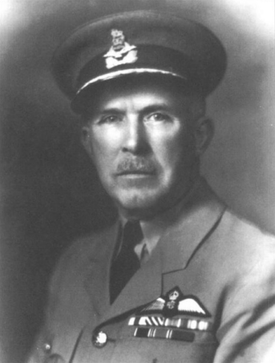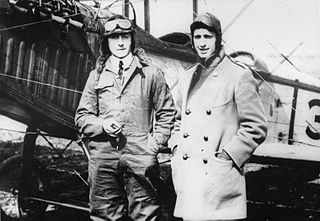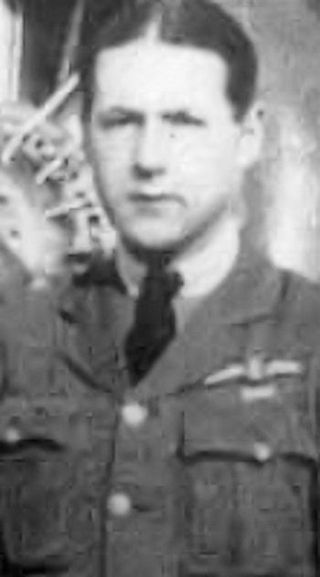Related Research Articles
Captain Carleton Main Clement was a Canadian First World War flying ace officially credited with 14 victories despite being handicapped by flying an obsolete plane.

Air Vice-Marshal Albert Earl "Steve" Godfrey MC was a Canadian First World War flying ace, officially credited with 14 victories while flying for the Royal Flying Corps. He spent the remainder of his career in the Royal Canadian Air Force.
Captain John Victor Sorsoleil MC was a Canadian First World War flying ace, officially credited with 14 victories.

Air Vice Marshal George Roberts Howsam, CB, MC was a Canadian First World War flying ace, officially credited with 13 victories. Serving in the newly formed Royal Canadian Air Force in the inter-war years, Howsam served as the RCAF's Director of Training during World War II.

Captain Ernest Charles Hoy DFC was a Canadian First World War flying ace, officially credited with 13 victories. He later pioneered airmail flight over the Canadian Rockies.
Lieutenant Harold Byrn Hudson MC was a Canadian First World War flying ace, officially credited with 13 victories. As wingman to William George Barker, he scored a record five victories over observation balloons in a single day.
Captain Ronald McNeill Keirstead DSC was a Canadian First World War flying ace, officially credited with 13 victories.
Captain Hazel LeRoy Wallace DFC was a Canadian First World War flying ace, officially credited with 14 victories. His record shows him to have been a notable team player in squadron tactics.
Lieutenant Harry Neville Compton was a World War I flying ace credited with five aerial victories.
Lieutenant George William Gladstone Gauld was a World War I flying ace credited with five aerial victories.
Lieutenant Harold Arthur Sydney Molyneux was a World War I flying ace credited with five aerial victories. During World War II, he returned to service in the Royal Canadian Air Force.
Major Oliver Stewart MC AFC (1896-1976) was a World War I flying ace credited with five aerial victories. Post war, he had a long and distinguished career as a writer.

Lieutenant Hilbert Leigh Bair began his service career as a World War I flying ace credited with six aerial victories.
Captain Henry Gordon Clappison was a World War I flying ace credited with six aerial victories.
Captain Ronald Sykes (1899-1977) was a World War I flying ace credited with six aerial victories.
Lieutenant Earl Frederick Crabb was a World War I flying ace credited with six aerial victories. After World War I, he was an aviation pioneer and bush pilot. He returned to military aviation during World War II. He flew as a commercial pilot until he was 72 years old.
Group Captain Gerald Ewart Nash was a World War I flying ace who went on to high command during World War II.

Lieutenant Kenneth Russell Unger was an American World War I flying ace credited with fourteen aerial victories. His candidacy rejected by his own nation, Unger applied to the British Royal Flying Corps for military pilot training in June 1917. Once trained, he was assigned to the Royal Naval Air Service (RNAS). As the RNAS was merged into the Royal Air Force, Unger scored his aerial victories between 26 June and 1 November 1918. In later life, Unger remained involved in aviation and served again during World War II. He also joined the U.S. Navy Reserves, rising to the rank of rear admiral.
Captain Stanley Stanger was a World War I flying ace credited with 13 confirmed aerial victories scored on the Italian Front. He was also noted for his ingenious escape from being captured by the Austro-Hungarians.
Captain Eric John Stephens (1895-1967) was an Australian flying ace who served in the Royal Air Force. He was credited with 13 confirmed aerial victories. He later became a Qantas pilot.
References
Above the Trenches: a Complete Record of the Fighter Aces and Units of the British Empire Air Forces 1915-1920. Christopher F. Shores, Norman L. R. Franks, Russell Guest. Grub Street, 1990. ISBN 0-948817-19-4, ISBN 978-0-948817-19-9.
Notes
- ↑ "The Aerodrome". www.theaerodrome.com. Retrieved 10 February 2010.
- ↑ Above the Trenches: A Complete Record of the Fighter Aces and Units of the British Empire Air Forces 1915-1920. p. 384.
Websites
"WWI Aces of Canada". www.theaerodrome.com. Retrieved 14 June 2008.